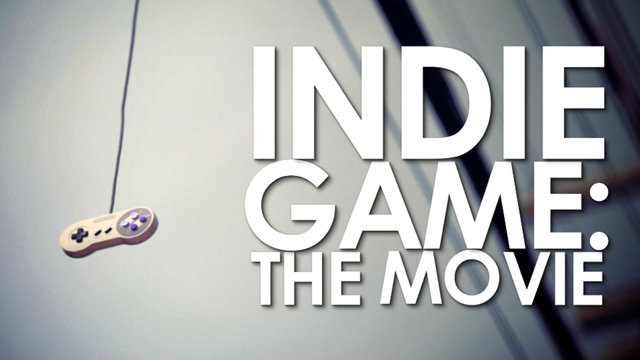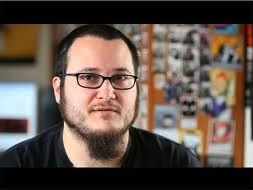
For many of us, the burgeoning world of indie games represents a new frontier: a digital Wild West where affordable tech, shorter development cycles, and outside-the-box design have created a level playing field for some talented minds. In the past few years, an avalanche of innovative content has flooded the Web, and today it's easier than ever to find independent games on your computer, your home console, and your cell phone.
And yet we don't know much about the people who make these games. The very nature of limited-budget titles means most of their designers ply their trade anonymously. But as indie games continue to grow, people are starting to ask: What's the story with these guys?
Filmmakers James Swirksy and Lisanne Pajot of Blinkworks Media feel the same way. With the upcoming documentary Indie Game: The Movie, they plan to shed new light on independent games and the people who bring them to life.
I recently had the opportunity to speak with Swirsky, and in our two-part conversation, we talk about triple-A games, the world of competitive air guitar, and the process behind funding and crafting this exciting documentary.
Paul Alexander: You guys are independent filmmakers working on a shoestring budget. Could you explain how you've gotten financial support for Indie Game: The Movie?
James Swirsky: Our budget is kind of an amalgamation of a variety of sources. The most significant chunk of money anchoring the budget is the result of an overwhelmingly successful Kickstarter campaign we put up back in May. Originally, we set our target at $15,000 — enough to cover the hard travel costs associated with our initial shooting plan. We weren't looking to fully finance the entire film via Kickstarter. Rather, we were using the service in the true sense of "kickstarting" the project.
With the target of $15,000 set, we believed in the project, its audience, and the strength of our pitch. We felt confident that we would reach the goal in about 30 days, but we hedged our bets and decided to give ourselves 60 days.
So you can imagine our surprise when — 48 hours after launching the campaign — we reached, and started to exceed, our goal. It was an awesome experience that was extremely encouraging and validating. Most of all though, we feel it's a real testament to the indie community and indie spirit. When this community feels strongly about something and wants to see something happen, it gets behind it and makes that thing happen.
We finished up with around $23,000 from the Kickstarter campaign. But equally (and maybe even more) important to the money was the fantastic word of mouth created and contacts we made via the campaign. Since launching the project, we have received a huge number of very generous offers — ranging from music, graphic art, interns, Steadicam operators — tons of very talented people just wanting to be involved.
The remainder of the budget is being comprised of personal funds, pre-sales of the DVD, some wonderful Canadian tax incentives, a PitchFest win at the WestDoc conference, and air miles. A surprising amount of travel has been booked through my points…how indie is that? (Is the leveraging of a loyalty programs indie? I don't know; we'll have to get a ruling on that one.)
So basically, we have assembled a budget that covers our hard production costs. All wages are being deferred, and we are leveraging our talents and equipment built up through the last 10 years or so from our production company, BlinkWorks.
PA: The subjects in your film are artists working on a budget as well, but it characterizes their approach to gamemaking in a unique way. How has this limitation affected your approach to making the film?
JS: I think operating with a limited budget has pretty much defined and shaped us as filmmakers. Like many in the indie-game community can attest to, when you're operating as an independent anything, you are forced to fill many roles. In our case, nearly every project we've done over the past 10 years has been with a crew of one or two people (although every now and then we may bring people on for specific shoots). And it's the same one or two people from conception of the idea, to the shoot, to the post-production.
As a result, we've developed the mentality that if a project requires a new technique, talent, or skill, we go out and learn it. It's an ongoing process that has made us versatile filmmakers and enabled us to tackle a large, ambitious project with just two people. If this were three to five years ago, we likely wouldn't have been ready for such a large project. But now it seems to be the natural next step for us as filmmakers and storytellers.
Another side effect of being a small team is that it allows for our crazy (and budget-minded) travel schedule. A team of three to five people would be a different beast. And when you're conducting long, more intimate interviews, the smaller your crew, the better.
PA: Speaking of your crazy schedule, I know you've been on the road for some time. Could you give us some idea of where you have traveled and who you've been talking to, say, this past week? [Ed. note: This interview took place in early October.]
JS: Last week we spent five days in Austin, Texas, conducting interviews with Adam Saltsman (Canabalt), [Independent Games Festival] Chairman Brandon Boyer, and Messoff (Nidhogg), and attending the Fantastic Arcade festival. The interviews provided some nice meaty content, while Fantastic Arcade was hosting Nidhogg and Canabalt tournaments that we thought would add nicely to the film's visuals. On our last day we shot over to Houston to film Jonathan Blow (Braid), who it just so happened was giving a lecture at nearby Rice University. We then traveled 18 hours by car to our "home base" in Phoenix and spent two days on the computer, managing footage and replying to emails. Tomorrow it's off to Montreal to spend four days with Phil Fish (Fez).
After that, we were invited by Kickstarter to speak at New York Comic Con! It was an opportunity we couldn't pass up. So we will be there attending Comic Con and the Vimeo Festival. This will be the closest thing we have resembling a break for a while. After that it's some heavy interviewing.
PA: How far along would you say you are in terms of finishing the actual film? Obviously, you're still collecting material….
JS: We're about 40-percent complete in our shooting. By December, we plan to have the first major portion of filming done. If all goes well, we'll have around 80 percent of the film shot. From there, we'll start editing, but we'll continue to shoot some pick-ups and follow story threads as they progress. Our hope is that we'll have a pretty solid cut this time next year. Hopefully sooner.
PA: You mentioned conducting long, intimate interviews. Are there any that stick out in your mind as being emotional or even difficult?

JS: We still have a lot more interviews to conduct, but the ones that immediately come to mind are our very first interviews with Tommy and Edmund of Team Meat. Those guys are truly artists expressing themselves in this medium. And as a result, when you ask them about their games, they can't help but talk about their experiences and feelings as they relate to the game. In the most beautiful way, Super Meat Boy is Tommy and Edmund, and Tommy and Edmund are Super Meat Boy. And that type of relationship, connection, expression…whatever you'd like to call it, that is this movie. The openness and honesty with which those interviews occurred showed us that there was a movie waiting to made.
Mosey on over to part two of the interview for talk of triple-A games and competitive air-guitar championships.
For news, videos, and info on how to preorder your copy of Indie Game: The Movie, be sure to visit their website, where you'll also find instructions on how to help support the film via PayPal donations. You can follow James and Lisanne's exploits on Twitter at @indiegamemovie.
VentureBeat's mission is to be a digital town square for technical decision-makers to gain knowledge about transformative enterprise technology and transact. Learn More
